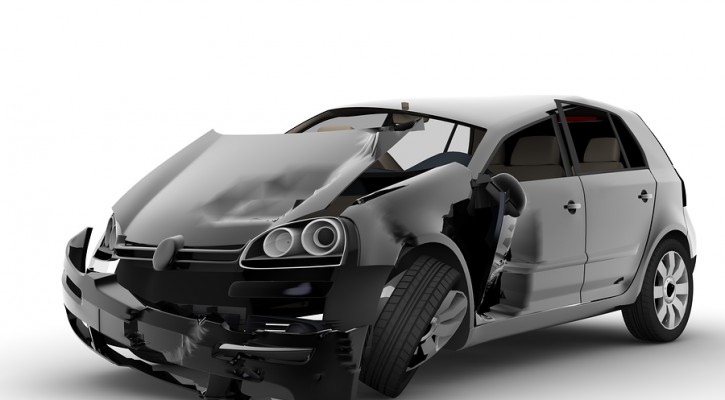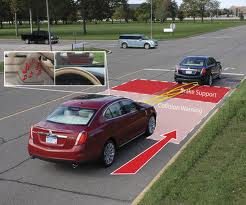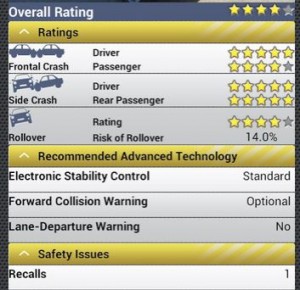
Nine Car Models Have Zero Deaths
February 3, 2015
A study, released last week by the Insurance Institute for Highway Safety (IIHS), looked at the death rate for 2011 model year vehicles sold in the US and the data showed a record nine models with zero deaths.
According to the authors, the chances of dying in a vehicle crash have fallen by more than one-third over the past three years. Significant improvements in design safety, including; structural improvements, additional safety features, and “an evolving mix of vehicle types” contributed to the decline in the risk of death. The authors estimated that, had vehicle designs remained the same since 1985, an additional 7,700 people would have died.
Vehicle structural improvements and safety features have improved tremendously over the past few years. The 2011 models sold through the 2012 calendar year had an overall rate of 28 vehicle deaths per million registered vehicles compared to 48 deaths per million registered 2008 vehicles sold through 2009. According to the IIHS, eight years ago there were no vehicles with a zero death rate and now there are nine.
The surprising thing about the vehicles that had zero deaths were that two-thirds of them were SUVs. This is surprising because SUVs had some of the highest death rates ten years ago due to the fact that their high center of gravity made them prone to roll over in a crash. When they did roll over, their weak roofs generally gave way, crushing the vehicle occupants. Structural changes and the addition of electronic stability control (ESC) led to lower death rates, not only in SUVs but throughout the vehicle fleet. According to the authors, the 2011 rollover death rate of 5 per million registered vehicle years is less than one-quarter of that for the 2004 model year. A registered vehicle year is one vehicle registered for one year.
The nine vehicles with zero death rates are:
|
Audi A4 4WD |
luxury car |
midsize |
|
Honda Odyssey |
minivan |
very large |
|
Kia Sorento 2WD |
SUV |
midsize |
|
Lexus RX 350 4WD |
luxury SUV |
midsize |
|
Mercedes-Benz GL-Class 4WD |
luxury SUV |
large |
|
Subaru Legacy 4WD |
4-door car |
midsize |
|
Toyota Highlander hybrid 4WD |
SUV |
midsize |
|
Toyota Sequoia 4WD |
SUV |
large |
|
Volvo XC90 4WD |
luxury SUV |
midsize |
Smaller vehicles, especially the “minis” or “smart cars” fared poorly in the study. The car with the highest death rate was the Kia Rio, a minicar, with 149 driver deaths per million registered vehicle years. The Rio, along with the Nissan Versa sedan, and the Hyundai Accent, were the only three cars with more than 100 deaths per per million registered vehicle years. In small and mini cars, there isn’t enough vehicle structure to cushion and prevent intrusion into the vehicle occupant space.
To see how your 2011 model fared in the study: visit: Driver death rates by make and model

Automatic Braking On NHTSA Wish List
February 2, 2015
Automatic braking systems are being recommended by the National Highway Transportation Safety Administration (NHTSA) for new cars under its New Car Assessment Program. The announcement of this recommendation was made by U.S. Transportation Secretary Anthony Foxx on January 22.
NHTSA is recommending two different types of automatic braking systems that go beyond crash avoidance systems, currently available in some car models, that only warn the driver of an imminent crash. The systems that NHTSA recommends including in all new cars are known as Crash Imminent Braking (CIB) and Dynamic Brake Support (DBS).
If the driver has not already applied the brakes the CIB system automatically applies the brakes if the vehicle detects that a crash is imminent. The DBS system takes over and applies more braking force if it detects that the driver is not applying enough force to stop in time.
According to Foxx’s announcement, approximately one-third of collisions in 2013 were rear-end collisions with another vehicle. The evidence showed that many drivers in those crashes either didn’t apply the brakes at all or didn’t apply enough braking force to avoid the crash. It’s hoped that these two braking systems can help avoid those crashes.
The automatic braking systems being recommended by NHTSA aren’t new technology, they already exist in some higher end model vehicles. In 2013, the Insurance Institute for Highway Safety (IIHS) added automatic braking systems to the requirements for a vehicle to earn the designation as a “Top Safety Pick +” in its annual list of safest cars. Auto manufacturers are adding them to more and more vehicles in order to earn the top safety plus designation. IIHS announced that, for the 2015 model year, a record 33 vehicle models won the top safety pick plus designation.
It’s unclear, as of now, if the NHTSA recommendations will become mandatory for new vehicles in the near future.

If The Home Team Loses, You May Lose Too
January 30, 2015
When the home team loses, auto collision rates increase around NFL stadiums. This finding is the result of a study by the Highway Loss Data Institute. The Institute looked at insurance collision claims in zip codes for 31 NFL stadiums and zip codes nearby.
The researchers found that claims went up on days when home games were played. This may make sense due to the large amount of traffic around an NFL stadium on game days but reasons behind these crash claims go deeper than that.
Not only did claims go up on game days, there were big differences based on whether the home team won or lost. When the home team won, the crash rate increased by 3.2 percent compared to days when the team was out of town. When the home team lost, the crash rate was 9.4 percent higher.
What would explain the higher crash rate when the home team loses? Driving safety experts have long known that driver emotions are the driving force behind car crashes. No matter the emotion, any emotion, whether good or bad, that can take your mind off the road can lead to a crash.
Drivers, who may be elated by a win and in a celebratory mood, may not be devoting their full concentration to the road ahead. Drivers who are upset or angry by the loss may also be giving less attention than needed to the road ahead but their anger can also make them impatient with other drivers. Their anger and frustration may also lead them to take chances they might not otherwise take.
With the Super Bowl approaching, no matter where they live, fans all over the nation will be attending Super Bowl parties, either at private homes or sports bars. Even though the teams involved may not be the home team, ardent football fans will root for one team or another and passions will be high. Alcohol, which is a depressant, may be involved, adding to the anger and frustration for fans of the losing team.
Drivers need to be aware of these emotions and the effect they may have on their driving. If you bet on a team and lose, your anger will most likely be even greater. Spouses or partners of rabid football fans may want to take over the driving duties after the game regardless of who wins or loses.
If alcohol is involved in your Super Bowl plans, make sure you have a plan for getting home either with a designated driver or by calling a cab.
One team has to lose and that means, unless fans can put the game behind them and concentrate on the road, other drivers who aren’t invested in the game will be in danger too.
Read more: Home team loss boosts collision claim rates around NFL stadiums

Can Courtesy Keep You Safe On The Road?
January 28, 2015
Courtesy is a hallmark of Japanese culture. It’s hard to think of Japan without the vision of hyper-polite citizens bowing to each other. One theory of Japanese etiquette is that it developed long ago to deal with the problems of a very large population living and working in a very small country. Along with courtesy, there’s also a strict adherence to society’s rules. This led me to wonder if Japanese courtesy and adherence to the rules extended to the roadways and how Japanese drivers compare with those in the US.
Japan is a tiny country. Japan’s 145,925 square miles – slightly smaller than Montana – make up less than four percent of the total land area in the US. In order to compare the two countries, we have to look at population density. The US with its wide open spaces has a population density of only 88.6 people per square mile. Japan’s population density, by contrast, is 873.1 people per square mile. That makes for very crowded conditions.
Out of all the nations in the world, the US has the greatest number of registered vehicles on the road. That may not come as a great surprise but the country with the second greatest number of registered vehicles is Japan. The US has 846.2 registered vehicles per 1,000 people followed by Japan with 650.9 vehicles per 1,000 people. Not only is Japan a crowded country, their roads are crowded too.
With that many vehicles in such a small space, you might think that Japan would have a high roadway death rate but that isn’t the case. When comparing the highway fatality rate of the two nations, the figures look like this:
|
Country |
Fatalities per 100,000 inhabitants |
Fatalities per 10,000 vehicles |
|
Japan |
4.1 |
0.6 |
|
US |
11.6 |
1.3 |
According to The International Transportation Forum, in 2012, the total highway fatality rate in each country was:
|
Country |
Total fatalities |
Percent change from 2011 |
|
Japan |
5,237* |
-4.9 |
|
US |
33,561 |
+3.3% |
*Out of all the highway deaths in Japan, 36% were pedestrians.
When you think of the US, you tend to think of a fast paced life style but Japan’s society is every bit as fast paced, if not more so.
When comparing speeding between the two countries:
- In the US in 2012 speeding was responsible for 30% of all fatalities with 10,219 lives lost in speed related crashes; an increase of two percent over 2011.
- In Japan, between 2002 and 2012, the number of crashes outside the motorway network involving speeds above 100 km/h (62 mph) decreased by 82%.
Could it be that the Japanese sense of courtesy and adherence to societal rules is responsible for the large difference in highway death rates? If Americans were just as courteous and law abiding on the roads, could we drastically reduce our highway death rates? There’s only one way to find out.


